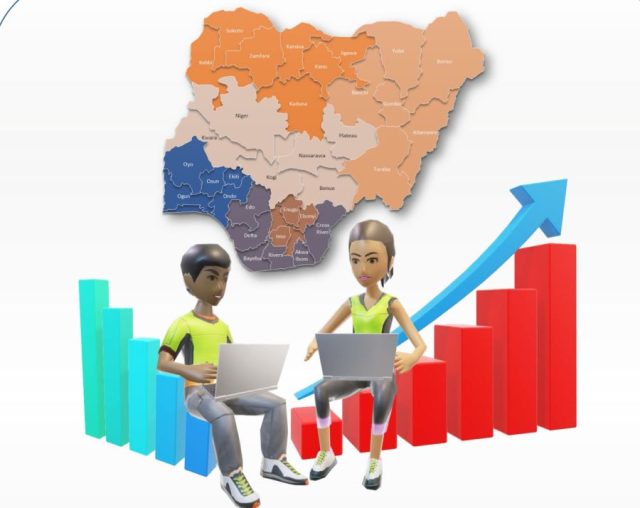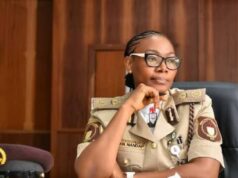MON, APRIL. 17 2023-theGBJournal | A new report released by the National Bureau of Statistics (NBS) today- ”STATISTICAL REPORT ON WOMEN AND MEN IN NIGERIA 2021”-reveals the stark inequalities and differences between women and men in the country.
The report seen by theGBJournal, and which the NBS says ”offer an essential numerical representation of realities”, covers and includes data on seven crucial policy areas of the economy- Population, Health, Education, Work and Security, Power and Decision Making, Violence Against Women and Girls, and Exposure to Media. And in each of these areas, statistics from primary and secondary sources are presented, highlighting some differences between the status of girls, boys, women, and men.
”It is hoped that this publication will help develop an enabling social, political, and economic environment that supports policymaking for the equal treatment of all its citizens, with special consideration for the status of women in the nation,” says Prince Semiu Adeyemi Adeniran Statistician-General of the Federation/ Chief Executive Officer National Bureau of Statistics (NBS).
Among others, the report highlighted what it called ”the high-levelled disparities” between the participation of men and women in the domain of politics and decision-making, limit women’s political, social, and economic opportunities.
”Women have continued to suffer in all facets of politics and leadership positions, despite the recognition of the importance of women’s political empowerment within the framework of the SDGs,” it says.
The gender inequality in the domains stated above, the NBS says, is owing to the limited number of female participations in government, especially, where key policy decisions are made and resource allocations are decided.
Women have continued to suffer in all facets of politics and leadership positions, despite the recognition of the importance of women’s political empowerment within the framework of the SDGs, and despite the fact that Women population is estimated to account for almost half of the total population in Nigeria.
The NBS in the report notes that since independence in Nigeria, the male has been the major actors in politics. Women had
rarely been represented in any of the three arms of government.
”It is becoming a norm that men play the most important roles in politics, particularly at the federal level with regards to the position of president, vice president and secretary to the government of the federation as well as appointive ministerial positions.”
In this regard, the NBS data shows that in 2016, only 7 females were appointed as ministers, and this decreased in 2017 to only 5 females. Female Ministers appointed in 2018 and 2019 were 6 and 7 respectively. Women have never been appointed as secretaries to the government of the federation since independence.
According to the report, since the return of democracy in 1999 to the last election in 2019, women have been underrepresented in the National Parliament. The highest representation of 7.2 per cent was recorded in 2007-2011, it was 6.6 per cent each in 2011 – 2015 and 2015-2019. The current women’s representation in National Parliament.
Males dominated the principal office in the Senate. A total of 6 women and 73 men occupied principal positions in the Senate in 2016 and the figures stood for 2017. 2018 and 2019 recorded the same figures of 7 women and 72 men as principal officers. From 2016 – 2019, only 6 women occupied the position of committee chairperson each year. In 2018 and 2019, a woman occupied the position of Minority Senate Leader in the Senate.
Men also dominated the House of Representatives in Nigeria, only 9 women were among the 106 principal officers in each of the years (2016 – 2019). A woman held the position of Deputy House Minority Whip and only 8 women were among 96 Committee Chairpersons across the years (2016 – 2019).
At Judiciary, female members of National Judicial Officers in 2016 and 2017 were 31.87 and 31.98 per cent respectively, while in 2018 recorded 28.86 per cent. No female had been Chief Justice of Nigeria, President of the National Industrial Court and Chief Registrar of the Supreme Court from 2016 to 2018. In the same period, a female had been the President of the Court of Appeal.
The statistics on violence against women is stark. For instance, the report says that, the percentage of women aged 15 – 49 who have ever experienced physical violence since age 15 increased from 27.8 per cent in 2013 to 31 per cent in 2018.
In 2013, the percentage of women aged 15-49 who experienced physical violence since age 15 irrespective of the perpetrator was highest in Edo state with 75.4 per cent, followed closely by Benue state with 72.1 per cent.
Among women aged 15-49, the percentage that ever experienced sexual violence irrespective of persons that committed it was 7.4 per cent in 2013 and increased to 9.1 per cent in 2018.
According to the NBS, the conceptual approach of the Report is in line with those published from 2008 to date i.e., gender-disaggregated analysis of key social and economic indicators across several areas of contemporary life within the country.
Twitter-@theGBJournal|Facebook-the Government and Business Journal|email:gbj@govbusinessjournal.ng| govandbusinessj@gmail.com










